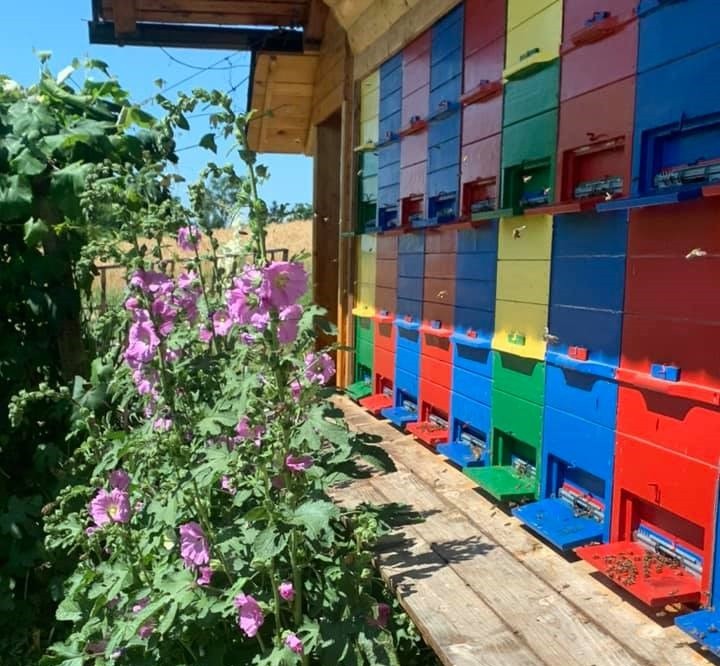The buzzing of bees brings life to our gardens, their honey sweetens our lives, their venom is used in medicine against inflammation, candles made of beeswax bring lights on dark evenings, and propolis is good for our immunity.
Why Do We Need Bees?
Bees are the main support of our ecosystem. More than 80% of indigenous flowering plants depend on their pollination. Without this cross-pollination most plants would not have fruits or seeds. Our entire landscape, our diet and the future of flora and fauna would be threatened. Bees are indispensable for the plant world.
The Bees Are In Danger
The survival of bees also depends on the nectar and pollen of the plants they feed on.
It is a cycle of giving and taking. Just a few years earlier, fields and meadows offered an abundance of diverse flowers. The cereal fields also contained a handful of poppies, cornflowers and many other field flowers. The meadows were like colored carpets of flowers. The industrialization of agriculture has destroyed much of this abundance.
Organic plants are lacking in conventional corn fields. Today, those fields are just green or yellow. Meadows are intensively turned into pastures. Because of that, bees are starving and if beekeepers did not feed them, in some regions they would not even survive.
By applying pesticides such as insecticides and herbicides, bees are endangered. They absorb these harmful substances which then poison and disorient them so that they no longer find their way to the hive and die.
Planting genetically modified plants also has an impact on bees. Biological balance and natural diversity are increasingly threatened. Bees cannot distinguish whether a plant is genetically modified or not. Thus insects spread altered pollen and contaminate areas that are not genetically modified with agro-genetic technology, simply performing their natural life task.
Furthermore, the dangers posed by globalization are diseases, parasites and viruses. Our bees do not recognize this phenomenon and have no defense mechanisms against it. The most famous example is the Varroa mite from Asia. Without treatment by beekeepers all bee communities would disappear.
The Life Of Bees
About 40,000 bees live in the hive. There is only one queen in each colony. It is larger than the others, we recognize it by its body size and short wings. Its only task is to lay up to 2,000 eggs a day and thus take care of the population of the bee community. The queen mates only once in her life, during the so-called wedding summer. This can take several days, during which the queen mates with more drones, ie male bees.
The largest part of the bee colony consists of worker bees. Their lifespan depends on how hard they work. Bees that work in the summer do not live as long as those that work in the winter. The workers take care of the care and food for the larvae and the queen. They build a hive producing honeycomb wax. They make honey from nectar.
After three weeks, the worker bees become able to fly. They fly out of the hive, collect nectar, pollen and water and bring everything back to the hive. Thousands of male bees – drones – also live in each hive. They do not have a poisonous sting and develop from unfertilized eggs. Their function is to mate with the queen.
Since they cannot take care of their own food, they are fed and cared for by crankshafts. They die immediately after the mating season or in winter at the latest, and when they run out of food, they are pushed out of the hive.
How To Help Bees By Planting Various Flowers
Bees, bumblebees and butterflies are irreplaceable. As pollinators, they ensure the diversity of flora and fauna. The link between valuable insect forgiveness and crop size is clearly visible in fruit growing: without the pollination of the apple blossom in the spring by bees and other insects, there would not be much fruit in the fall.
Even in wild plants, there are many examples of such interdependent plant-insect relationships. In order for bees and other insects to survive, they need a sufficient amount of food and living space from early spring to late autumn. Gardeners have many options to provide habitat and food for tiny visitors to their gardens.

Some Of The Plant Species That Bees Visit A Lot
In The Vegetable Garden
Fresh herbs are not only a delicious ingredient for our dishes, but are also loved by insects. Plant it; bees and bumblebees will enjoy herbs such as sage, pepper, basil, mint, lemon balm, dill, marjoram, thyme, butterbur, chives. Also vegetables like onions, carrots and leeks are surprisingly beautiful when allowed to bloom. Refresh the edges of your vegetable garden with marigold and borage.
In The Flower Garden
Numerous shrubs, annuals and biennials are a source of pollen and nectar. It is important for insects that the plants do not have the so-called “Double flowers”, which make it difficult for them to get nectar. In the spring, the flowers of bulbous plants are especially suitable (eg visibaba, saffron, crevice, narcissus).
The most interesting to bees are the plants with head inflorescences (eg starfish, sunflower), dahlias, marshmallows, yellow padlock. You can attract bees with balcony pots (eg yellow padlock, bluebells, marigold, sagebrush). Instead of geraniums from which insects have no benefit, plant the above flowers!
Trees And Shrubs In Your Garden
Trees and shrubs that bloom in early spring offer good food for insects. Indigenous species provide fruits and flowers. The most suitable are: fruit trees, berry bushes, dogwood, viburnum, devil, willow, hazel, barberry and wild rose without “double flowers”.

